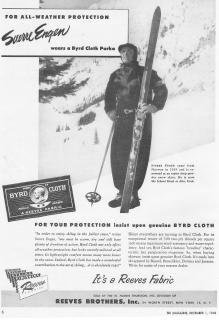Ads from the Past: Before Gore-Tex: Byrd Cloth

Now that perfluorocarbon waterproofing (so-called PFCs or “forever chemicals”) are banned, it’s worth looking back at the natural fibers skiers used to keep their sweaters dry before 1970, when Gore-Tex arrived. Sailors stayed dry with oil-cloth beginning around the time Columbus sailed. It was made by soaking linen or cotton canvas with fish oil or, later, linseed oil. Charles Macintosh sandwiched rubber between two layers of cotton or linen cloth in 1823. This stuff wasn’t breathable, so sweaty climbers and skiers adopted Grenfell cloth beginning in 1925.
Invented by Walter Haythornthwaite, Grenfell was a tightly-woven, long-staple cotton twill. Byrd cloth was the American version, promoted by Admiral Richard Byrd beginning in 1934. Light and comfortably windproof, the stuff became popular for golfing, shooting, climbing and skiing and would hold off a light rain but not a downpour.
Waxed gabardines became popular for rainy weather in the 1930s, but the wax had to be refreshed periodically. After WWII, ski-wear designers switched to nylon and polyester, often coated with impermeable polyvinyl chloride (PVC)—another nonbreathable choice. A breathable successor to Grenfell/Byrd cloth was 60/40, a blend of polyester and cotton. This ad ran 75 years ago in the November 1948 issue of SKI.
Coming Up In Future Issues
- Ski Reports by Roxy: This daily radio show thrilled Eastern skiers in the 1960s with its underground reports on snow conditions filed by a volunteer network of local ski-area “spies” who described the reality underfoot.
- Resorts Then and Now: Everett Potter explores the rich history of skiing at Cortina d’Ampezzo, deep in the Italian Dolomites.
- The New World Cup: Edie Thys Morgan explains the growing influence of “private teams” on the World Cup circuit.
Visit the ISHA website: www.skiinghistory.org
Join our Facebook page: www.facebook.com/skiinghistory